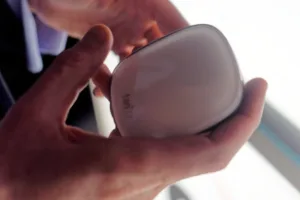Last year, one of the most impressive demos that we got was at Rovi when the firm showed us its natural language user interface tool. The system was good at understanding the context and likely meaning of requests. This year, the company has added Spanish to English as a supported language and there have been developments in the tools available to operators. There is a new “conversation training tool” that allows local operators to add local words and dialects. The tools can also be used to add trade names and special words.
Rovi has a new voice gateway that is being developed with Nuance, which the firm believes is the best of the current generation of technologies and “Dragon TV” will be pre-integrated into the system. Rovi’s contribution is its “Conversation Services” tool which is built on a “Knowledge Graph” containing semantic, real-time information on more than 100 million entertainment-related entities, like programme titles, celebrity names, brands and other relevant elements.
All these features are intended to help particularly in countries with multiple languages, such as Switzerland which not only needs four main languages, but also has a variety of special words in different parts of the country.
Rovi continues to work on its metadata services and databases and has added the Philippines, India and Australia. The big thrust in the metadata is to improve the experience for viewers as they have access to both OTT and linear TV and the key is integration to allow easy switching and content discovery. There were demonstrations of how the metadata could be use in sports broadcasting for pre- and post-match content discovery and to improve the user experience.
Rovi recently conducted a survey of 4,000 people in the US (1,000), China, France, Germany, India, Japan and the UK. It found only 3% of people who were “cord cutters” (although this increased to 7% in the US). Subscribers were also prepared to pay a small increment ($1.99) in monthly cost to improve the quality of services. As we reported, based on Ericsson’s research before IBC (Ericsson Consumer Lab Adds Data to TV Trends), Rovi found that 73% of viewers are frustrated when they can’t find something to watch and a typical viewer spends 19 minutes per day looking for content.
The Rovi front end for sets is built on HTML5 and is based on HbbTV technology. The middleware communicates with cloud services to customise content for users’ different menu choices. Content is based on the preferences and profile of particular users. The profiles are “open”, with no security. There is a “classic” EPG list, but from there, or from a user home page, viewers can move around the content using content names, genres and sub-genres and people as well as titles. There is what Rovi calls “Deep Linking” to allow connections between the different types of metadata.
Rovi acquired Fan TV at the end of 2014 and has been working to integrate its technology and databases. The company had developed a small Android-based box that has an unusual remote with no buttons that it can supply to TV makers or to other device makers. The Fan TV box had been sold through Time Warner Cable.

